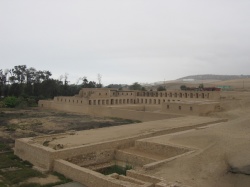Pachacamac: Culture is Liberty
7 September, 2007, 04:42 am in "Peru"
 The minibuses to Pachacamac do not stop on the corner of Ayacucho and Grau as stated in the Lonely Planet. To get to the stop you have to walk a block up the street then down to the stations that are in a lowered street. Easier still, we could have caught the bus from Plaza Grau which is about 2 blocks from our hostel.
The minibuses to Pachacamac do not stop on the corner of Ayacucho and Grau as stated in the Lonely Planet. To get to the stop you have to walk a block up the street then down to the stations that are in a lowered street. Easier still, we could have caught the bus from Plaza Grau which is about 2 blocks from our hostel. The bus was very crowded and about half the way to our destination I received the answer to a question that has been running through my head lately: What happens when the minibuses break down? Ours broke down with a clamourous rattle of metal and a billow of smoke. Everyone got off the bus. As more minibuses pulled up behind ours, the our conductor paid the conductor of the new bus for each passenger that boarded. The bus route went through what probably wasn't the most fashionable part of town--industrial areas mixed with crowded living spaces. A couple areas were hills that were completely covered with concrete and brick houses, one seeming to grow out of the other. It was as if the entire hill was made out of ramshackle buildings. No street was visible (though there must have been something). On one I noticed a steep yellow stairway which stretched up the "mountain."
Pachacamac is in an area which on one side overlooks the ocean. One side overlooks fertile fields and one side looks toward the desert. The ruins are from several different time periods. Usually I shy away from guides when visiting places, wanting freedom to linger over one thing or anotehr or just willing to read signs and descriptions myself. However, realizing how many ruins there were and how many were just piles of bricks, we decided a guide would help enlighten us.
Our guide, Marcelo, rocked! He was enthusiastic, knowledgable, had a great sense of humor and fine storytelling skills. He was possibley the most interesting tour guide I´ve been on a tour with. He moved quickly, which I appreciated, and insterted the history into the conversation in enticing tidbits, instead of long boring descriptions. Sometimes he'd speak secretively then suddenly burst out into a dramatic explanation. He explained about the Wari, the Lima, the Icha and the Inca (making sure we remembered the names). He showed us the clay vessels made for drinking or snorting mescaline and recommended "no more than 2 cups" ferment corn alcohol.
The Lima ruins, he explained, were recognizable by the bricks being set vertically which made them stand up better during earthquakes (They could move with the wave as opposed to crumbling.) He talked about the class issues through time and how the nobles walked on the raised edges of the road above the heads of the commoners.
One thing he mentioned several times was how upset he was that more money wasn't being spent on the excavation and restoration of the ruins. He said that excavation would answer more questions and make the people more knowledgable about their history. "Culture is liberty." That is probably my favorite line that he said. Culture shows the best of every society. It is what is produced to express what is loved most by the people and what is most important. By letting a people know their cultural history, they can know what is best about who they are and who they were. It is important to have that pride.
Comments
- Comments
Powered by My Blog 1.69. Copyright 2003-2006 FuzzyMonkey.net.
Created by the scripting wizards at FuzzyMonkey.net..
(Code modified by Rowshan Dowlatabadi)
Created by the scripting wizards at FuzzyMonkey.net..
(Code modified by Rowshan Dowlatabadi)

